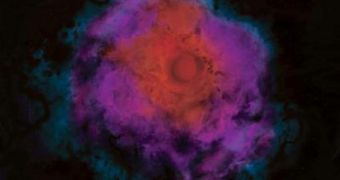New studies seem to suggest that the earliest stars which appeared soon after the Universe was created were not made out of regular matter, but rather from the strange substance known as dark matter.
The concept of dark matter was introduced in astrophysics by experts trying to explain how is it that galaxies stick together, and also their motion towards knots of matter called superclusters.
But no one has thus far been able to identify the stuff, and not for want of trying. Detectors are located everywhere, from the deepest mine to Earth's orbit, and yet dark matter continues to elude science.
Scientists now appear convinced that the stuff is what the earliest stars were made of. But determining precisely how their formation process took place is a very complex issue.
Solving it could lead to a better understanding of dark matter itself, and so scientists are prepared to take on the assiduous task of analyzing the early Universe in search of answers.
The new investigation essentially calculated which of the theorized forms of dark matter may have been responsible for producing dark stars, cosmic structures with no regular matter inside them.
“Not all kinds of dark matter would be able to form dark stars. In this sense dark stars are a tool to understand the nature of dark matter,” explains University of Utah expert Paolo Gondolo.
He is also the leader of a new scientific issue detailing the findings, which appeared in a recent issue of the esteemed Journal of Cosmology and Astroparticle Physics, Space reports.
The expert goes on to say that the title dark stars are in fact misleading to the general public. A dark matter star would emit light just like a regular one, except it would not be made out of regular matter.
“If we detect evidence of dark stars, or if we can say that there are no dark stars, then they present constraints” on what dark matter is made of, the team leader says.
He adds that future space-based observatories such as the James Webb Space Telescope (JWST) may be able to detect the elusive substance, which is now only visible through the gravitational pull it exerts on stars and entire galaxies.
The JWST is scheduled for launch in 2014, when it will replace the venerable NASA Hubble Space Telescope. The latter is not equipped with the necessary tools to find the stuff.
One of the prevailing ideas out there is that dark matter particles are their own antimatter. Bring two of them close enough and they would annihilate each other, the theory goes.
But conditions today are not ripe for this to happen, given that matter is spread out thin throughout the Universe. But the situation was different in the earliest days of the Universe.
A smaller size meant a more tight distribution of matter, which in turn allowed dark matter particles to meet, destroy each other, and produce energy in the process.
Some of that energy may have been released as light, similar to the way nuclear fusion reactions release light inside regular stars.

 14 DAY TRIAL //
14 DAY TRIAL //